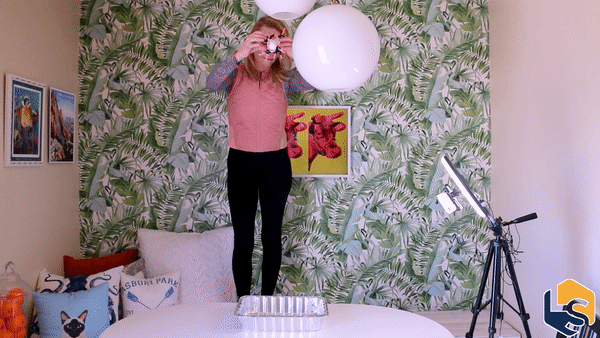Summer School with Live Science: Egg Drop Challenge

This Friday (June 18), we will explore the critical field of engineering in our new kids video series: Summer School with Live Science.
In this week's installment, Live Science producer, Diana Whitcroft, will demonstrate how to construct a capsule that will securely land a raw egg without breaking it. She will provide her own design, intended to protect this delicate payload from a mere 4- to 5-foot drop. Watch along with your kids and get inspired to engineer an even better contraption meant to land from even greater heights!
Every Friday at 3 p.m. EDT (12 p.m. PDT), Diana will host Summer School With Live Science, which you can find live on Live Science's Facebook, YouTube and Twitter pages. Every week, the series will explore a different field of STEM (science, technology, engineering and mathematics) through simple hands-on experiments that you and your child can follow along with at home.
Disclaimer: It is strongly advised that all science experiments, recipes and methods be attempted only under adult supervision. Adults are required to handle or assist with any potentially harmful utensils and ingredients. Always wash hands thoroughly after trying any experiment. Avoid touching your face and eyes when performing any experiments, and if possible, wear glasses or safety goggles. Do not ingest any of the ingredients during or after performing this experiment.
Egg Drop Challenge: Objective
Age Range: 6+ years
Construct a capsule or package to secure and successfully land a raw egg, unfractured from a fall to the ground.
Step One: Make Blueprints
If you plan to experiment with a landing capsule of your own design, (and you really should), sketch it out! First, determine the height from which you plan to drop your egg. Then, assess the kind of materials available to you and go from there. Draft as many designs as you'd like and select one to build.
Sign up for the Live Science daily newsletter now
Get the world’s most fascinating discoveries delivered straight to your inbox.
Keep in mind that it is completely possible your egg might not survive the fall. Don't be discouraged by this. Simply work with another of your ideas until you land a happy, fracture-free huevo. After all, we can learn just as much through our failures as we do our successes.
Most students prefer the idea of encasing their eggs within enclosed capsules like shoe boxes or tupperware. Many, looking for a loftier egg drop, lean toward creating the force of drag by the use of parachutes. In Diana's demonstration, she set out to use the fewest and simplest materials possible, by creating a paper straw barrier to protect the egg from its 4-foot journey to the floor.
Step Two: Build Your Landing Capsule
How you go about constructing your piece is entirely up to you and is dependent upon the complexity of your contraption. Log your methods, so that you and your child can determine why your drop was successful (or unsuccessful). In the case of our paper straw capsule, Diana found that by using paper straws instead of plastic straws, and by first taping the straws against the egg with clear tape and then reinforcing the connecting parts with electrical tape, she was able to engineer a more encompassing and structurally sound device.
Step Three: Drop It Like It's Hot
After you've designed and engineered your device to withstand the desired drop height, be sure to use measuring tape to figure out roughly how high to hold your egg before releasing it. This experiment is better performed outside. To avoid wasting an egg or making a mess, set up a drop cloth or a tray to catch any spatter. Wear protective eye gear and either a smock or apron. To better record your results, try setting up a camera to record the drop.
Step Four: Log Your Results
Whether this experiment was a success or a yolky failure, write it down. Make this a summer-long project if you'd like by constructing a series of contraptions to see how high you can successfully land an egg, or even go head-to-head with family members to see who can make the best landing capsule. The more creative you get with your designs, the more you'll learn.
Document this experience and send images to us either on social media or to community@livescience.com. We'd love to see your results so that we can feature them in our photo gallery!
Why Perform An Egg Drop?
Have you ever watched NASA's video illustration of the landing of Mars rovers, Spirit and Opportunity? Compare those landings to that of Perseverance. Have you ever wondered how we deliver aid and general goods to devastated or hard-to-access areas of the world? This activity aims to give kids an idea of how we achieve these goals.
By engaging in this highly versatile activity, kids are effectively simulating these real-life applications and in doing so, learning the importance of design iteration through trial and error. It is an exceptional way to introduce engineering design to young minds.
General physics and materials science are also highlighted in this experiment. Whether you and the family choose to drop a straw capsule from a 4-foot height or send your egg off with a parachute from a two-story landing, students are challenged to engineer a device that would decrease the amount of impulse of the egg that gets transferred from potential energy into kinetic energy on the egg's shell. When objects collide, (in this case, the egg with the ground), their energy and momentum are changed or transferred. These processes are mediated by one or multiple forces — the force that gets the egg moving and transfers its potential to kinetic energy is … gravity. Then upon contact with the ground or surface, the kinetic energy must be transferred somewhere and that’s the point of impact. If the forces acting on the egg are too strong, that can cause the shell to fracture. Thus the development of these different engineered structures to divert this energy from the sensitive payload or reduce the kinetic energy altogether (i.e. parachutes).
Originally published on Live Science.

Diana Whitcroft joined Live Science and Space.com in the fall of 2017. After receiving a B.F.A in Directing & Producing for Film and Television, she worked as a video editor at CNBC in Englewood Cliffs, New Jersey. During her time in broadcast television, she created a role for herself as a "Science Preditor" in which she produced and edited content specific to the business aspect of the private sector space industry. Searching for a deeper role within the science journalism sector, Diana came to Space.com and Live Science as a Social Media Producer, handling multimedia content for all social pages. She is a hardcore trekkie, comic nerd, environmentalist, video-gamer and all-around space geek.









